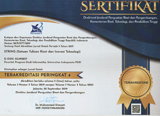Studi Struktur Serat Agave Menggunakan Fourier Transform Infrared Spectroscopy
(1)
(2)
(3)
(*) Corresponding Author
Abstract
Agave plants are ornamental plants that generally grow wild in the yard or empty land. Apart from being an ornamental plant, agave plants have many uses and benefits. The use of agave plants is located on the plant fibers. One of the benefits of agave fiber is the material used to make a composite material for applications in the medical or industrial fields. The purpose of this study was to determine the fiber characteristics of agave plants including the crystallinity and regularity of agave fibers by testing using Fourier Transform Infrared (FTIR) Spectroscopy. Characterization with FTIR can be obtained information of C-O stretching cellulose 1 and sesulose 2 groups, C-H aromatic groups, C = C stretching aromatic ring (G) groups, C = C stretching aromatic ring (S) groups and OH groups from Agave fibers. Agave fibers are made in two different types of samples. The first sample is pure fiber without treatment called (UT) and the second sample, namely fiber with soaking sodium hydroxide (NaOH) is called treatment fiber (T). The results obtained show that T fibers have a degree of crystallinity and strength based on higher OH groups compared to UT fibers.
Keywords
Full Text:
PDFReferences
Castañeda-Nava JJ, Rodríguez-Domínguez JM, Camacho-Ruiz RM, Gallardo-Valdez J, Villegas-García E, Gutiérrez-Mora A. Morphological comparison among populations of Agave salmiana Otto ex Salm-Dyck (Asparagaceae), a species used for mezcal production in Mexico. Flora Morphol Distrib Funct Ecol Plants. Vol. 255. 18–23. 2019. https://doi.org/10.1016/j.flora.2019.03.019
Dana A. Hackman, Nicole Giese, John S. Markowitz, Adam McLean, Steven G. Ottariano, Chris Tonelli, Wendy Weissner, Shannon Welch & Catherine Ulbricht. Agave (Agave Americana), Journal of Herbal Pharmacotherapy, 6:2, 101-122. 2006.
DOI: 10.1080/J157v06n02_09.
Espinosa-Barrera LA, Sánchez-Teyer LF, Quiroz-Moreno A, Narváez-Zapata JA. Identification and characterization of a new satellite-like DNA family in three Agave species. Plant Gene. Vol. 16. 8–18. 2018.
Mylsamy K, Rajendran I. The mechanical properties, deformation and thermomechanical properties of alkali treated and untreated Agave continuous fibre reinforced epoxy composites. Mater Des. Vol. 32 No. 5. 3076–3084. 2011.
http://dx.doi.org/10.1016/j.matdes.2010.12.051
Zuccarello B, Zingales M. Toward high performance renewable agave reinforced biocomposites: Optimization of fiber performance and fiber-matrix adhesion analysis. Compos Part B Eng. Vol. 122. 109–120. 2017.
http://dx.doi.org/10.1016/j.compositesb.2017.04.011
Jain D, Kamboj I, Bera TK, Kang AS, Singla RK. Experimental and numerical investigations on the effect of alkaline hornification on the hydrothermal ageing of Agave natural fiber composites. Int J Heat Mass Transf. Vol. 130. 431–439. 2019.
https://doi.org/10.1016/j.ijheatmasstransfer.2018.10.106
Torres-Tello E V., Robledo-Ortíz JR, González-García Y, Pérez-Fonseca AA, Jasso-Gastinel CF, Mendizábal E. Effect of agave fiber content in the thermal and mechanical properties of green composites based on polyhydroxybutyrate or poly (hydroxybutyrate-co-hydroxyvalerate). Ind Crops Prod. Vol. 99. 117–125. 2017.
http://dx.doi.org/10.1016/j.indcrop.2017.01.035
Binoj JS, Bibin JS. Failure analysis of discarded Agave tequilana fiber polymer composites. Eng Fail Anal. Vol. 95. 379–791. 2019.
https://doi.org/10.1016/j.engfailanal.2018.09.019
Geethika VN, Rao VDP. Study of Tensile Strength of Agave Americana Fibre Reinforced Hybrid Composites. Mater Today Proc. Vol. 4 No. 8. 7760–7769. 2017.
https://doi.org/10.1016/j.matpr.2017.07.111
Nesimnasi, Jorhans J.S., Boimau, K., & M. Pell, Yeremias. Pengaruh perlakuan Alkali (NaOH) Pada Serat Agave Cantula Terhadap Kekuatan Tarik Komposit Polyester. Lontar Jurnal Teknik Mesin Udana Vol. 2 No. 1. 2015.
El Oudiani A, Msahli S, Sakli F. In-depth study of agave fiber structure using Fourier transform infrared spectroscopy. Carbohydr Polym. 164:242–248. 2017.
http://dx.doi.org/10.1016/j.carbpol.2017.01.091
Langhorst A, Paxton W, Bollin S, Frantz D, Burkholder J, Kiziltas A, et al. Heat-treated blue agave fiber composites. Compos Part B Eng. 165: 712–724. 2019.
https://doi.org/10.1016/j.compositesb.2019.02.035
Aprianto, G., Pasek Nugraha, I Nyoman, & Rihendra Dantes, Kadek. Pengaruh Fraksi Volume Serat Terhadap Sifat Mekanis Komposit Matriks Polimer Polyester Diperkuat Serat Agave Sisal. Jurnal Jurusan Pendidikan Teknik Mesin (JJPTM) Vol. 5 No. 2. 2016.
Subyakto, Hermiati, E., Yanto, D. H. Y., Fitria, Budiman, I., Ismadi, Masruchin, N., Subiyanto, B. Proses Pembuatan Serat Selulosa Berukuran Nano Dari Sisal (Agave sisalana) dan Bambu Betung (Dendrocalamus asper). Jurnal selulosa Vol. 44 No. 2. 2009.
DOI: http://dx.doi.org/10.30998/string.v4i2.3754
Refbacks
- There are currently no refbacks.
Copyright (c) 2019 Fita Widiyatun, Neng Nenden Mulyaningsih, nurfidah dwitiyanti

This work is licensed under a Creative Commons Attribution 4.0 International License.
STRING (Satuan Tulisan Riset dan Inovasi Teknologi) indexed by:

Ciptaan disebarluaskan di bawah Lisensi Creative Commons Atribusi 4.0 Internasional.
View My Stats


 Sertifikat Akreditasi
Sertifikat Akreditasi
















